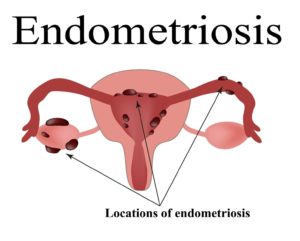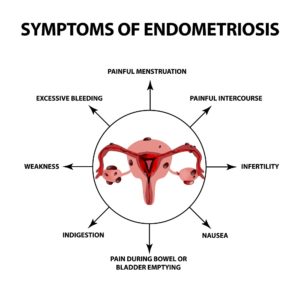Endometriosis is a painful condition where endometrial tissue, the kind usually found inside your uterus, is

Common sites for endometriosis
growing somewhere else in your pelvic region. This rogue tissue causes pain with exercise or sexual intercourse, painful periods, and possibly infertility.
The only way to confirm someone has endometriosis is to have laproscopic exploration. With this procedure a skilled surgeon uses a scope to identify the endometrial tissue. Generally, the surgeon will remove any endometrial tissue that is found during the same procedure. Seeds of endometrial tissue can be in several places and require the surgeon to “explore” to find all the areas that need to be excised.
Your doctor may recommend pelvic floor physical therapy (PFPT) to help you manage endometriosis pain. If so, I’m sure you are wondering about PFPT treatments.
What is Pelvic Floor Physical Therapy (PFPT)?
PFPT is a branch of physical therapy which deals with everything that affects your pelvic area. This includes muscles, bones, tendons, ligaments, and fascia all around your pelvis and hips. Therapists are specially trained for this, which requires additional education after becoming a Licensed Physical Therapist. PFPT for endometriosis is different from PFPT for other issues, like incontinence and postpartum care. People that suffer from Endometriosis often have more complex health issues, and require additional time and treatment to address their symptoms. PFPT for endometriosis can include:

Manual therapy helps release restrictions from scar tissue
- Work on your core, hips, and feet, to optimize the balance of forces that influence the pelvis to move
- Manual therapy for pelvic floor muscles to improve the flexibility and contractibility of the affected muscles that line the inside of the pelvis
- Manual therapy for your hips, legs back, and abdomen to help break up scar tissue and reduce restrictions
- Exercise, yoga, or Pilates
- Breathing exercises, as breathing affects the pelvis through the diaphragm
Why does pelvic floor therapy help?
Restriction and inflammation from endometriosis can cause muscle spasms in the pelvic floor and throughout the pelvis. It can also irritate the nerves in your pelvis and abdomen that creates pain. Bloating and poor fluid movement in the abdomen due are common.

We know that the best way to treat endometriosis is to have laparoscopic excision surgery — taking the disease out at its root — but often the symptoms are not resolved with surgery alone. Adaptations that the body has made while coping with endometriosis pain, often require additional treatment and training to untangle.
We need to attend to the nerve sensitivity, the muscle spasms, any postural alignment problems, the weakened core, and all the other things that have happened to the body as a result of coping with endometriosis. Removing lesions will help with the disease; but rebalancing the body after excision surgery is often needed to begin managing the pain.
If you decide to try PFPT, finding a qualified therapist is important. Listings for Pelvic Floor Physical Therapists are available at the American Physical Therapy Association in the section on Women’s Health. Pelvicrehab.com. will allow you to search the Herman and Wallave Pelvic Institute database. PelvicGuru.com also has a Health Professionals directory.
Any therapist that you choose to work with should be able to clearly explain what has been identified in their exam, and any specific treatment recommendations. Experienced therapists will have a variety of strategies for treatment.
For more information on managing your endometriosis, check out endometriosis.org


